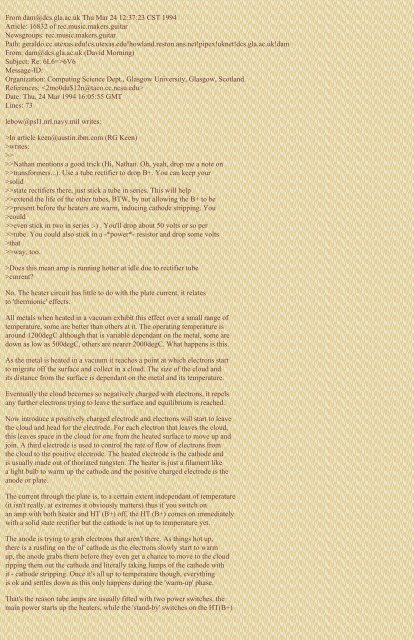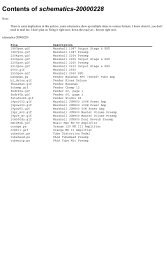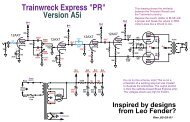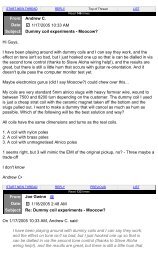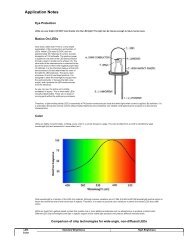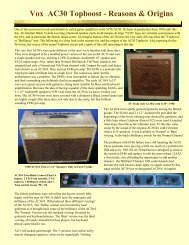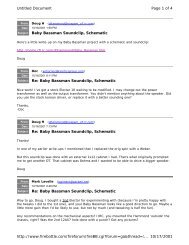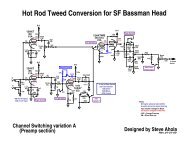Mic Kaczmarczik's TubeInformation - The Blue Guitar
Mic Kaczmarczik's TubeInformation - The Blue Guitar
Mic Kaczmarczik's TubeInformation - The Blue Guitar
Create successful ePaper yourself
Turn your PDF publications into a flip-book with our unique Google optimized e-Paper software.
From dam@dcs.gla.ac.uk Thu Mar 24 12:37:23 CST 1994<br />
Article: 16832 of rec.music.makers.guitar<br />
Newsgroups: rec.music.makers.guitar<br />
Path: geraldo.cc.utexas.edu!cs.utexas.edu!howland.reston.ans.net!pipex!uknet!dcs.gla.ac.uk!dam<br />
From: dam@dcs.gla.ac.uk (David Morning)<br />
Subject: Re: 6L6=>6V6<br />
Message-ID:<br />
Organization: Computing Science Dept., Glasgow University, Glasgow, Scotland<br />
References: <br />
Date: Thu, 24 Mar 1994 16:05:55 GMT<br />
Lines: 73<br />
lebow@psl1.nrl.navy.mil writes:<br />
>In article keen@austin.ibm.com (RG Keen)<br />
>writes:<br />
>><br />
>>Nathan mentions a good trick (Hi, Nathan. Oh, yeah, drop me a note on<br />
>>transformers...). Use a tube rectifier to drop B+. You can keep your<br />
>solid<br />
>>state rectifiers there, just stick a tube in series. This will help<br />
>>extend the life of the other tubes, BTW, by not allowing the B+ to be<br />
>>present before the heaters are warm, inducing cathode stripping. You<br />
>could<br />
>>even stick in two in series :-) . You'll drop about 50 volts or so per<br />
>>tube. You could also stick in a -*power*- resistor and drop some volts<br />
>that<br />
>>way, too.<br />
>Does this mean amp is running hotter at idle due to rectifier tube<br />
>current?<br />
No. <strong>The</strong> heater circuit has little to do with the plate current, it relates<br />
to 'thermionic' effects.<br />
All metals when heated in a vacuum exhibit this effect over a small range of<br />
temperature, some are better than others at it. <strong>The</strong> operating temperature is<br />
around 1200degC although that is variable dependant on the metal, some are<br />
down as low as 500degC, others are nearer 2000degC. What happens is this.<br />
As the metal is heated in a vacuum it reaches a point at which electrons start<br />
to migrate off the surface and collect in a cloud. <strong>The</strong> size of the cloud and<br />
its distance from the surface is dependant on the metal and its temperature.<br />
Eventually the cloud becomes so negatively charged with electrons, it repels<br />
any further electrons trying to leave the surface and equilibrium is reached.<br />
Now introduce a positively charged electrode and electrons will start to leave<br />
the cloud and head for the electrode. For each electron that leaves the cloud,<br />
this leaves space in the cloud for one from the heated surface to move up and<br />
join. A third electrode is used to control the rate of flow of electrons from<br />
the cloud to the positive electrode. <strong>The</strong> heated electrode is the cathode and<br />
is usually made out of thoriated tungsten. <strong>The</strong> heater is just a filament like<br />
a light bulb to warm up the cathode and the positive charged electrode is the<br />
anode or plate.<br />
<strong>The</strong> current through the plate is, to a certain extent independant of temperature<br />
(it isn't really, at extremes it obviously matters) thus if you switch on<br />
an amp with both heater and HT (B+) off, the HT (B+) comes on immediately<br />
with a solid state rectifier but the cathode is not up to temperature yet.<br />
<strong>The</strong> anode is trying to grab electrons that aren't there. As things hot up,<br />
there is a rustling on the ol' cathode as the electrons slowly start to warm<br />
up, the anode grabs them before they even get a chance to move to the cloud<br />
ripping them out the cathode and literally taking lumps of the cathode with<br />
it - cathode stripping. Once it's all up to temperature though, everything<br />
is ok and settles down as this only happens during the 'warm-up' phase.<br />
That's the reason tube amps are usually fitted with two power switches, the<br />
main power starts up the heaters, while the 'stand-by' switches on the HT(B+)


